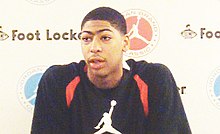Unibrow
This article has multiple issues. Please help improve it or discuss these issues on the talk page. (Learn how and when to remove these messages)
No issues specified. Please specify issues, or remove this template. |

A unibrow (or monobrow) is a "confluence of eyebrows"; that is, the presence of abundant hair between the eyebrows, so that they seem to converge to form one long eyebrow. The condition of having a unibrow is medically named synophrys.
Beauty culture
In times past and in some cultures, for example Tajikistan,[1] the unibrow is viewed as an attractive quality in men and women alike. In some places, it may be associated with purity and, in men, virility, while most Western societies seem to find it unappealing. Men in Western cultures may pluck, tweeze, or use other treatments for unwanted hair to rid themselves of this feature. In Western perception, the unibrow may make a person seem ugly, fierce, grumpy, or overly serious, so much so that the unibrow has become something of a cliché in fiction, especially with cartoon characters. In some non-Western cultures, however, this facial hair does not have a stigma, and may even be seen as a sign of feminine beauty, where connected eyebrows are a sign of virginity and of being unmarried.
The first pick of the 2012 NBA Draft, Anthony Davis of the University of Kentucky, recently trademarked the phrases "Fear the brow" and "Raise the brow" in reference to his famed unibrow, a rare instance of positive associations with a unibrow in Western Culture.
Make up (unibrow simulation)
In many countries of Central Asia a unibrow is considered attractive in women. If there is no unibrow present, or if it is weak, it is drawn with kohl liner or a modern kajal pen to simulate a unibrow. This is only done by women and girls. During the Qajar Dynasty in Iran, unibrows were considered attractive in women, however this has changed with time.
Removal
Among western people, the region between the brows is often plucked, waxed, shaved, or otherwise treated with electrolysis or other forms of depilation. Unibrow separation is often the only form of eyebrow grooming (a stereotypically feminine behavior) among men.
Waxing and tweezing are the most efficient methods for removing eyebrow hairs. The eyebrows can shape the eyes and make a considerable difference to a person's appearance.
Science
While the prefix of the scientific term "synophrys" links the latter to the preferred medical term, many discount the idea that it stems from developmental disorders. It is a recognised feature of Cornelia De-Lange syndrome, a genetic disorder whose main features include moderate to severe learning difficulties, limb anormalities such as oligodactyly (fewer than normal fingers or toes) and phocomelia (malformed limbs), and facial abnormalities including a long philtrum (the slight depression/line between the nose and mouth) and bushy eyebrows.
Genetics and prevalence
There have apparently been no scientific studies of the unibrow in culture or whether certain ethnic groups are more prone to developing a unibrow or not (or less likely to pluck them or not).
Superstition
Unibrows have been the subject of various misconceptions and superstitions. Victorian criminologist Cesare Lombroso identified unibrows as a sign of criminality.[2]
References
- ^ Elder, Miriam (November 27, 2010). "Where the unibrow reigns". Global Post. Retrieved November 13, 2011.
- ^ [1][dead link]
